Effective power management embodies the fabric of modern-day data center operations. In the era of increased demand in computational work and data storage, maintaining energy efficiency transforms from being purely cost-effective to playing an important role in sustainability. The power distribution center is at the core of all data center energy management systems. It is sophisticated with reliability in rest power delivery, monitoring, and load balancing. This article assesses the contribution of PDUs in the overall operational efficiency of large-scale data centers, offers solutions to common challenges occurring in power distribution, and the transformational features that are changing how dolor centers utilize energy.
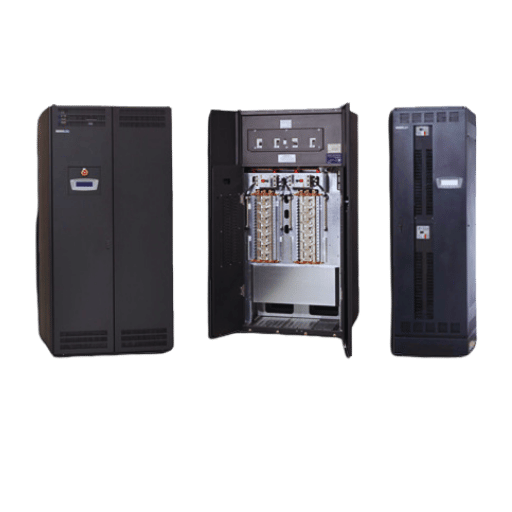
In a data center, the Power Distribution Unit (PDU) is one of the most important devices since its primary function is to supply power to servers, networking equipment, and other major infrastructures. It acts as a central point for managing power distribution as well as making sure that all the connected devices receive enough power to function efficiently. PDUs also assist in monitoring power usage for overloading while optimizing energy consumption which helps the data center’s stability and efficiency.
For the optimal distribution of electrical power in data centers or network facilities, a PDU system Power Distribution Unit is necessary. A PDU unit can power up connected appliances including servers, storage devices, and networking equipment. Surge protection features, load monitoring attributes, and remote management units are available in modern PDUs. These features ensure that managers can optimize power distribution, monitor loads, and avert overloads. PDUs greatly assist in maximizing power usage while enabling efficient operations and minimizing downtime risks.
Power Distribution Units (PDUs) are installed within server racks to distribute electrical power to rack mounted equipment. They are designed to take in a range of power, ensuring they can be used throughout different standards and equipment. PDUs mount both vertically (along the sides of a rack) or horizontally (flat within the rack) depending on the design of the server rack.
Advanced Utility PDUs assess utility and efficiency with additional modern features. For instance, intelligent or “smart” PDUs allow real-time observation of energy consumed at an outlet level and report usage over time. This knowledge can aid data center managers balance the power load in the racks. Adapter-equipped PDUs can now control power from any location which allows monitoring of other remote Facility Distribution Units. Smart PDUs have been reported to save operational costs by alleviating power waste by 30%.
Also, PDUs are designed with circuit breakers and surge protectors to prevent power spikes and electrical faults from damaging critical hardware. One of the most notable features of a PDU is its ability to perform load balancing, which prevents network outages by minimizing the chances of any single circuit becoming overloaded. Industry benchmarks indicate that there is an average reduction of 15% in unintentional power outages when intelligent PDU load-balancing features are utilized.
PDUs help manage modern racks by combining precision, efficiency, and reliability, allowing optimal power distribution while putting critical IT infrastructure at minimal risk of damage.
The specifications of current data centers have fostered different types of Power Distribution Units (PDUs), each with individual operational and technical solutions which are basic PDUs, metered PDUs, monitored PDUs, and others.
Basic PDUs
These are the simplest types of power distribution units, intended for effortless use and for dividing power from one single circuit input to diverse circuit outputs. They are mostly adopted in less critical functions or operations that do not require sophisticated control or monitoring. Economically, they are most suited for smaller structures. Unfortunately, these types of PDUs do not allow for remote monitoring or management of power which renders them futile in large and constantly changing data centers.
Metered PDUs
These types of PDUs have built-in meters that are capable of measuring power spent with real-time data. This allows managers of data centers to measure usage at the PDU level and better allocate resources. Research indicates that the efficiency of power consumption in facilities that monitor energy use can be advanced by up to 20% with the use of metered PDUs. This type of PDU is helpful for organizations with intentions of meeting energy compliance standards for planning and resource utilization.
Monitored PDUs
Without a doubt, these PDUs are the most advanced type and enable remote management and control of each outlet. Monitored PDUs allow the administrator to access real-time energy values on a unified interface, making it easier for them to manage interactions, as well as respond to any issues that may be related to power. Compared to metered PDUs, these devices assist in the reduction of the chances of downtime due to overloaded circuits. This is made possible, as managers receive alerts and are capable of taking action to balance the loads promptly.
Switched PDUs
Switched PDUs have proven to be the most detrimental in terms of adoption and use per data center. This enhancement allows for a greater reduction of primary operations downtime per data center. Many switched PDUs enable remote usage, which allows the administrator to reset a specific device or change energy management with the need to be on-site. These PDUs are estimated to decrease total operational downtime by 15% as compared to metered PDU switches. In addition, their ability to grant remote access to individual users enables improved total power management. High-density server environments benefit the most from switched PDUs.
Automatic Transfer Switch (ATS) PDUs
ATS PDUs are designed with redundancy in mind. These PDUs automatically switch to another power source when the primary source fails. This helps in continuous power delivery to critical equipment, thus avoiding outages. ATS PDUs are largely used in mission-critical environments where uptime is key. Research shows that implementing ATS PDUs into a power framework can increase reliability by 25% in facilities with backup power configurations.
The use of intelligent PDUs is on the rise in modern data centers. These intricate PDUs incorporate real-time monitoring, remote control administration, and advanced protective features. The type of PDU chosen determines the operational efficiency, scalability, and performance to be attained in various IT environments.
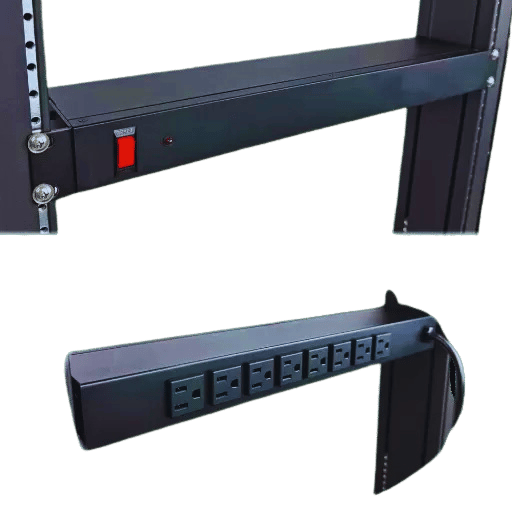
The installation of Power Distribution Units (PDUs) in racks easily optimizes power management in IT environments. One of these benefits includes offering detailed power monitoring. Modern rack PDUs can monitor power consumption at the rack and outlet levels in real-time, enabling administrators to assess energy consumption accurately. Intelligent rack PDUs can reduce energy waste by up to 20% with improved monitoring and adjustments.
Increased security of the equipment is another significant advantage. Surge protection and circuit breakers that protect against power surges and overloads are now standard in Rackmount PDUs. This protection greatly minimizes risks of downtime which, according to Gartner’s, can cost businesses around $5600 per minute for critical systems.
Remote management capabilities is another powerful feature that enables IT administrators to control power distribution and outlet switching from any location. This functionality leads to improved efficiency as well as a reduction in human intervention speedier responses to issues. A recent survey of IT managers revealed a 40% improvement in maintenance response times of data centers with remote monitoring services.
Moreover, numerous rack-mountable PDUs are crafted with scalability in mind which permits companies to change as their infrastructure expands. Higher-level models allow monitoring of temperature and humidity with the help of environmental sensors, which improves data center optimization. This flexibility guarantees that PDUs continue to be a reliable solution for changing IT systems, minimizing ownership costs over time.
Switched PDUs (Power Distribution Units) provide enhanced functionalities that dramatically enhance power management and control within a data center. Basic PDUs are not designed to manage individual ports remotely, whereas switched versions allow operators to remotely turn devices on, and off, reboot servers, or implement power cycling where necessary. This control works to increase efficiency and minimizes downtime resulting from maintenance work, device failure, or inefficiencies.
Recently, innovations have been concentrated on energy-efficient and actionable intelligence integration with intelligent monitoring systems that can manage total power within data centers. Monitoring real-time switched PDU power consumption has been made accessible with the use of remote control to locate energy wastage. For example, research shows that the use of intelligent PDUs can lead to as much as 20% reduction in energy use in optimized data centers. Furthermore, IT administrators are able to mitigate issues at the helm by alerting and logging events on a threshold basis further enhancing operational resiliency.
In more virtualized settings, advanced remote management is possible, as noted with switched PDUs. They are particularly useful in the context of edge computing, as switched PDUs allow physical location to not hinder the ability to access other power management tools. For instance, companies with edge data centers can realize substantial savings in costs and enhanced operational flexibility through the reduction of required personnel on-site and associated travel downtime. As such, these features answer the needs of flexible and extensible IT systems which switched PDUs cater to.
Monitoring energy use via Power Distribution Units (PDUs) is essential in aiding data center productivity and energy conservation. PDUs, particularly “smart” PDUs with metering options, allow real-time monitoring of power consumption on an outlet, branch or unit level. Such visibility enables IT administrators to measure energy consumption accurately to find inefficacies within their infrastructure.
Most modern PDUs come with management interface software, or at least a web-based management interface, designed to allow easy monitoring of energy use. These interfaces have essential metrics such as voltage, current, and kilowatts that may be used for analysis over a specific duration. For instance, modern networked PDUs are capable of notifying administrators when certain thresholds are surpassed, aiding in averting overloads and possible downtimes.
Providing relevant data also supports the importance of PDU monitoring in operation optimization. Recent studies reveal the installation of metered PDUs, when coupled with server consolidation and airflow optimization, can increase the data center energy efficiency by 20%. Moreover, insights from monitoring power are valuable in informing organizational capacity expansion plans while improving the Power Usage Effectiveness (PUE) metric.
Employing smart PDUs combined with energy management systems allows for the automation of processes like load balancing and power capping, which promotes sustainability. Moreover, modern PDUs are IoT-enabled, allowing accurate forecasting of power requirements and enabling proactive mitigation of issues without the need for human action. These functions further illustrate the role of PDUs in next-generation energy-efficient environment data centers.
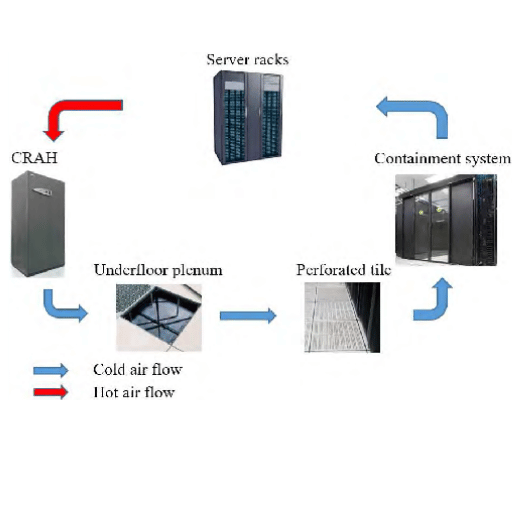
To determine the Power Usage Effectiveness (PUE) of a facility, I begin by dividing the total facility energy consumption by the energy used by the IT equipment alone. Simply put, PUE = Total Facility Energy / IT Equipment Energy. This helps me evaluate the energy efficiency of a data center and the degree of overhead energy expenditure unrelated to IT, which includes cooling and lighting. A PUE that approaches 1.0 shows the level of efficiency of the infrastructure, where the energy spent on non-value-adding activities is minimal.
Enhance Cooling Systems
Cooling systems are one of how power is utilized in a data center, therefore, optimizing them is crucial to enhancing the general energy efficiency of the data center. One of the strategies used in implementing hot aisle/cold aisle containment arrangements for managing the flow of air. In addition, due to having a greater cooling value than that of air, water or other non-conductive liquids is being increasingly adopted for use in liquid cooling systems. According to industry studies, maximizing cooling efficiency can lead to as much as a 40% reduction in energy expenditure.
Invest In New Technologies With Higher Energy Efficiency
The selection of new energy-efficient servers and storage devices aids in the reduction of energy used. With the focus on achieving optimal performance, modern processors with a lower thermal design power (TDP) and high-efficiency power supply units (PSUs) are constantly being manufactured. For instance, the replacement of older generation equipment with Energy Star-rated hardware can lead to around a 30% improvement in energy per workload.
Make Use of Virtualization Technologies
Virtualization permits several virtual machines to run on one physical server, which diminishes server volume while meeting the computation workload. With this method, resource usage can be optimized and can offer up to 80% in energy savings. Additionally, container technologies further enhance efficiency by allowing for simple scalable deployments with minimal resource expenditure.
Utilization of Renewable Energy Sources
Switching to sustainably sourced power such as solar or wind can compensate for the nonrenewable electricity that is consumed. Many companies are starting to build onsite renewables, or signing Power Purchase Agreements (PPAs) for green energy. These can then be fed to the PDUs of the data centers for maximum efficiency. Studies show that adopting these strategies for renewables enabled leading companies to lower carbon emissions by hundreds of thousands of metric tons every year.
Use of AI and real-time monitoring
Data centers equipped with advanced monitoring tools and AI analytics can mitigate the misuse of energy on the spot. For example, algorithms can forecast when there will be plenty of work and then distribute power or cooling in an optimal way that allows performing the tasks while not wasting resources. Research shows that having AI implemented increases energy efficiency by 15-20%
Adoption of DCIM (Data Center Infrastructure Management) Systems
A comprehensive DCIM platform with a built-in monitoring system offers a comprehensive overview of energy consumption, temperature, and equipment efficiency in a data center. With accurate optimization and automation enabled, the DCIM ensures that operators make well-informed decisions, resulting in observable improvements in energy efficiency, sometimes in the millions of kilowatt-hours saved a year.
These initiatives combined can enhance a data center’s operational efficiency while significantly reducing power consumption, operational expenses, and environmental impacts which helps drive global sustainability with no impact on reliability or performance.
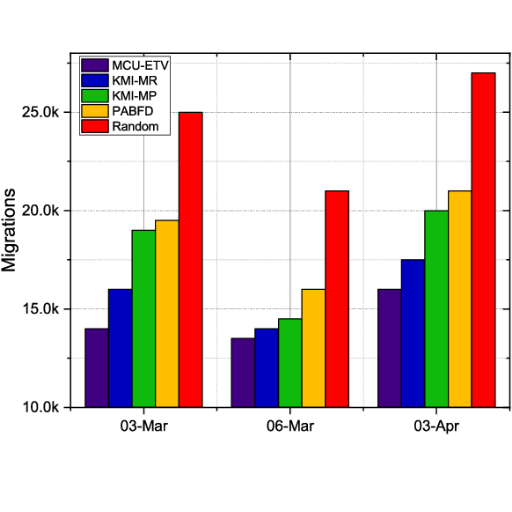
In today’s data centers, the monitoring and distribution of power is critical, and Power Distribution Units (PDUs) allow for both. The use of intelligent or metered PDUs within a Data Center Infrastructure Management (DCIM) solution allows operators to see power usage in real-time for every device that is connected. It is vital to use these units because they offer voltage, current, and power factor metrics that need to be precisely monitored to minimize energy consumption and maximize uptime.
Recent intelligence reveals that intelligent outlet PDUs can provide load balancing and proactive capacity planning to increase power efficiency by 20%. Moreover, modern PDUs often can be remotely monitored which lets data center admins quickly resolve power issues, mitigating the risk of downtime. This enables enhanced resource allocation since operators can redistribute workloads more easily to meet redundancy standards with the detailed data provided.
Furthermore, by equipping PDUs with environmental sensors, administrators can monitor server rack humidity and temperature levels. Evidence suggests this combination can deliver around 10-15% savings in cooling costs with more focused cooling techniques. Collectively, these advancements highlight how leveraging PDUs with DCIM software sustains, economizes, and strengthens the operations of data centers.
Contemporary data centers utilize Data Center Infrastructure Management (DCIM) software to supervise power usage in real-time. With DCIM advancements, data center operators can monitor and analyze power consumption effectiveness (PUE) and energy allocation to find suboptimal energy efficiency scenarios. Studies show that the adoption of DCIM tools can increase a data center’s energy efficiency by up to twenty percent, leading to further savings and mitigation of the ecological footprint.
Polished DCIM tools can visualize power usage at different levels such as the rack, row, and facility levels, thus enhancing the forecast accuracy of power consumption for effective capacity planning. This will also ensure that better load balancing and energy power prediction are enabled to avoid the risk of over-provisioning or underpowering the infrastructure. Furthermore, operators can quickly respond to sudden power shifts due to automated alert systems which ensures risk mitigation.
By integrating with smart power distribution units (PDUs), these benefits are magnified through granular control over energy allocation. These systems help in hotspot management, minimize the chances of circuit overload, and enable energy-saving techniques, such as dynamic provisioning. In general, using DCIM software for power monitoring improves operational efficiency and supports the sustainability objectives of the data center, addressing new regulatory and commercial transformations within the context of enterprise maneuvering strategy.
There is a strong reliance on backup power systems to keep operations in data centers running smoothly, particularly during power outages or grid instability. Data centers today utilize a combination of uninterruptible power supplies (UPS), backup generators, and battery energy storage systems For instance, one study indicates that the average data center suffers from 2.5 outages each year, 91% of which are due to power issues. For this reason, having a strong infrastructure already in place is necessary to guarantee uptime while mitigating disruptions.
While lead-acid batteries once dominated the market, lithium-ion batteries replace these due to their greater energy density, longer lifespan, and lower impact on the environment. Most importantly, UPS systems can provide immediate power through lithium-ion batteries during an outage, covering the time gap between the loss of utility power and the starting up of backup generators. Furthermore, advanced solutions implement online double-conversion UPS technology which cleanly powers data center equipment while isolating them from power fluctuations.
Once the UPS has stabilized the system, backup generators using diesel or natural gas fuel can then be switched into. These generators can be regularly tested and maintained to ensure their reliability. Additionally, the performance and responsiveness of modern backup generators have increased due to automated fuel monitoring and load testing.
The addition of solar panels and wind turbines into backup power systems is becoming increasingly common. Traditionally backed-up systems can now incorporate renewable energy sources along with battery storage, which helps in reducing operational costs and the carbon footprint of businesses. A case in point would be the installation of a hybrid backup system, which demonstrated a reduction in energy expenditures of 35% without sacrificing reliability.
In response to shifting downtime dynamics, data centers have begun applying AI-driven predictive analytics to continuously track the performance metrics of their backups to enhance power reliability. Such systems allow for proactive maintenance that minimizes the chance of unpleasant surprises. With the help of AI monitoring, data center operators can foresee system failure several weeks before it happens, enabling timely system maintenance or replacement.
The combination of robust backup power systems, advanced technologies, and the integration of renewable energies offers unrivaled reliability in modern data centers. They offer uninterrupted services to sustain business activities, comply with service-level agreements (SLAs), and contribute towards sustainability and operational efficiency objectives.
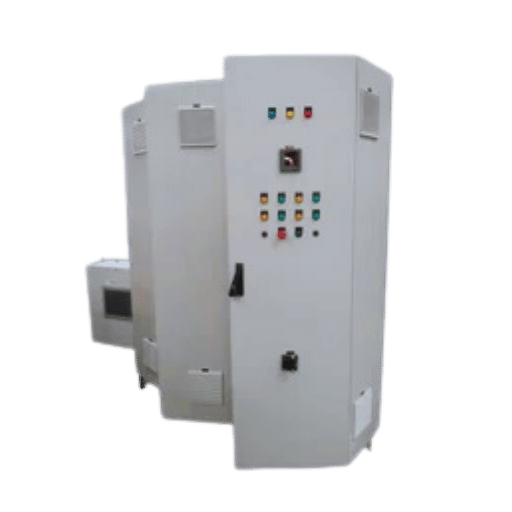
Higher Power Density
Large data centers can shift significantly more energy without requiring infrastructure overhauls. This is possible due to the higher efficiency offered by three-phase power systems relative to single-phase. For example, a three-phase system requires the same electrical wiring as a single-phase system but offers up to 1.73 times more power, optimizing energy distribution.
Improved Energy Efficiency
Three-phase systems utilize three separate conductors that have currents offset by 120 degrees to minimize energy losses during transmission. Data centers reap the benefits from reduced electrical resistance and increased overall performance, resulting in systems operating at higher than 90% energy efficiency.
Balanced Energy Loads
With three-phase systems, data centers with large amounts of IT equipment can take advantage of lower voltage drops caused by balanced electrical loads. Reduced equipment overloading enables systems and hardware to last longer while maintaining stable operations.
Scalability in high-demand environments
For rapidly growing data centers, three-phase power systems are the go-to option due to their ability to effortlessly scale with increasing energy requirements. These systems allow the seamless addition of new equipment and higher workloads without complete electrical reconfigurations.
Support for Advanced Cooling Systems
Many recent advancements in modern cooling technologies, essential for the efficient functioning of a data center, often need three-phase power for their operation. These include liquid cooling and precision air conditioning systems, which require the dependability and volume that three-phase systems provide to provide optimal conditions.
Reliability and Redundancy
Concerning cooling tower reliability, three-phase systems provide the most effectiveness and redundancy. Because of the construction of three phases, there’s always deliverable power through at least two phases if one phase becomes faulty. This assures, that for data centers, which do not have any downtime flexibility, minimum risk of operational disruption.
Cost Effectiveness in the Long Run
The three-phase systems come with high initial setup expenses; however, the result is a positive long-term value such as reduced operational costs due to boosted energy efficiency coupled with lower maintenance needs. This offers a long-term return on investment for massive facilities.
Data centers, with the integration of three-phase power systems, dramatically improve energy distribution and support performance enhancement while further achieving cost-effectiveness and sustainability regarding the operational objectives.
The effects of a three-phase power system on energy efficiency in data centers are particularly beneficial. Equipped with power drawn from three-phase sources, rack Power Distribution Units (PDUs) are more energy-efficient and scalable. PDUs are essential components for power distribution to IT systems and the integration of three-phase systems increases their capability to manage dense loads.
Improved Load Balancing
Three-phase systems also provide improved operational performance. The PDUs use combined power sources where power consumption is balanced among the three phases, which greatly reduces stress on the serving circuits. This balanced approach leads to more stable power delivery and minimizes the likelihood of overloading or overheating components. The research found that a balanced distribution of electric power enhances operational performance by 25% in most scenarios where the power fluctuates.
Higher Power Density in Reduced Space
Compared to single-phase systems, three-phase power distributes electrical power more effectively and efficiently. The low footprint can support high power outputs. For example, a typical three-phase rack PDU can support power outputs exceeding 22 kW. The reduced number of cords and connections required in the data center saves valuable rack space and simplifies cable management improving airflow and thermal performance.
Losses Reduced and Efficiency
Lee energy losses while transmission and conversion are done through the use of three-phase power. In conjunction with three-phase rack PDU utilization, electricity bill savings of approximately 3-5% can be achieved because of reduced electrical resistance and enhanced power factor. Economically, these savings are most relevant when proportioned to the full data center infrastructure, which decreases energy expenses and negative effects on the environment.
Future Expansion Scalability
Power demand in data centers is often raised as an organization grows and adopts high-performance IT systems in its operational scope. A scalable platform is provided by a phase power configuration in rack PDUs which supports expansion without requiring major changes to electrical wiring. This is very important to ensure that service is not disrupted during the evolution of infrastructure.
Management and Monitoring Capabilities
With sophisticated technology, temperature, humidity, and power use can now be monitored in real time through the intelligent monitoring systems that constantly check the parameters workers set. Data monitoring helps data center operators understand how efficiently or otherwise energy is consumed and take urgent decisions to change the situation to provide these goals, thus aligning operations with sustainability goals.
Achieving dependable, scalable, and energy-efficient performance in information-intensive environments revolves around the implementation of three-phase power in rack PDUs. Modern data centers can leverage its benefits to support complex workloads while achieving cost efficiencies and reducing environmental damages.
In regards to power options in data centers, whether AC (alternating current) or DC (direct current) is chosen, each has distinct advantages depending on the operational needs of the data center.
AC Power
DC Power
Key considerations
It is logical to decide on which power type to use by thinking through primary operational goals, current infrastructure or energy efficiency outputs.
A: A rack PDU or Power Distribution Unit is a device that specializes in power distribution and is commonly used within data centers. A basic power strip is different from a rack PDU as the latter is much more advanced in form and function as it is meant to power several servers and IT devices that are housed in a rack enclosure. It can remotely manage and meter power has higher power capacity, and is much more advanced than basic power strips, providing almost everything a data center requires.
A: PDUs are essential in improving efficiency in data centers as they allow for power monitoring, and controlling, as well as precise power distribution. They help reduce the workload for data center managers in terms of power distribution and load balancing, making sure that the service is uninterrupted. More advanced PDUs further aid in metered and switched PDUs, providing real-time data for power consumption and power control mounted remotely. This helps prevent overloads and power outages, making power distribution more efficient.
A: These are the types of PDUs designed for data center environments: 1. Basic PDUs are basic power distribution PDUs operating without any features such as a power strip. Metered PDUs: Provide the total power consumption data for the whole PDU. 3. Switched PDUs: Remote turn ON and OFF control for individual outlets of the PDU is possible. 4. Intelligent PDUs: Advanced monitoring, switching, and environmental sensing features are available. 5. 3-Phase PDUs: PDUs are of such type having high power density features.
A: A rackmount PDU assists in the management of power in a data center in such a way that power is distributed to multiple devices within a single rack. It also helps in the organization of power cables, thus reducing clutter and resulting in improved airflow. In addition, many rackmount PDUs are also metered, which allows data center managers to track power usage at the rack level, thus helping in identifying overload conditions and facilitating power capacity planning.
A: Metered PDUs have distinct advantages in a data center environment: they help with ascertaining energy consumption while offering real-time power usage information and assist in capturing energy consumed. 2. They help in checking available power capacity for effective planning. 3. They help managers avoid overloads of the circuits by enabling them to track the amount of power being consumed. 4. They allow precise billing for power consumed in multi-tenant data centers. 5. They provide insight into ways to improve energy efficiency.
A: The PDU works together with the uns-interruptible power supply to guarantee there is clean power for the IT equipment. The UPS conditions the utility power and supplies backup power, while on the other hand, the PDU distributes power to various devices. During power failure situations, the UPS total power to the PDU, and the PDUs distribute power to various end devices in the data center. This enables critical systems to operate without interruptions.
A: While choosing a PDU for a data center, it is important to consider: 1. The power demand of the equipment 2. Type of power provided: single-phase or 3-phase 3. Available rack space and form factor 4. Level of proprietary monitoring and management needed 5. Remote power control capabilities 6. Environmental conditions (temperature, humidity, etc.) 7. Scalability as well as any plans for expansion 8. Existing infrastructure and new constructions 9. Availability of sufficient funds.
A: Switched PDUs significantly improve capabilities for remote data center management. They enable data center managers to control the power to particular outlets from a remote location. This allows problems such as hung servers to be resolved through simple reboots without any trips to the data center. Further, power cycling of equipment and power sequencing can be administered remotely. Minimizing the need for physical presence reduces response time to emerging issues while improving the overall operational efficiency of the facility. Moreover, it provides flexibility in the control of electrical power distribution to the data center.
1. Title: An Innovative Approach to an Old Problem: Session Management in Next-Generation Mobile Networks
2. Title: Data Centre Resources Optimization Strategy Using Two-Phase Industrial Manufacturing Services Management Approach
3. Title: Survey of Airflow Management Measurement and Its Impact on Cooling and Energy Efficiency in Data Centers with Raised Floors
5. Datacenter
6. 19-inch rack